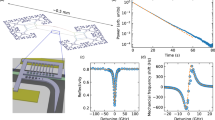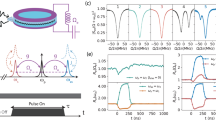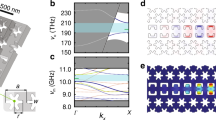Abstract
Magnetic-free optical non-reciprocal components, such as isolators and circulators, are highly desirable for on-chip optical signal processing1,2 and quantum networks3,4. However, their realization presents a fundamental difficulty due to the Lorentz reciprocity in most optical devices5. In this study, we propose and experimentally realize optical non-reciprocity with atoms embedded in a ring cavity at room temperature. Random thermal motion of atoms, in the presence of a unidirectional control field, creates susceptibility–momentum locking, and subsequently a new type of chiral quantum optical system. Furthermore, we demonstrate strong non-reciprocity based on this chiral quantum system in the regime of collectively strong atom–cavity coupling. Our scheme provides a new routine towards the realization of chiral quantum optics and chip-compatible, non-magnetic optical non-reciprocity.
This is a preview of subscription content, access via your institution
Access options
Access Nature and 54 other Nature Portfolio journals
Get Nature+, our best-value online-access subscription
$29.99 / 30 days
cancel any time
Subscribe to this journal
Receive 12 print issues and online access
$209.00 per year
only $17.42 per issue
Buy this article
- Purchase on Springer Link
- Instant access to full article PDF
Prices may be subject to local taxes which are calculated during checkout




Similar content being viewed by others
Data availability
The data that support the plots within this paper and other findings of this study are available from the corresponding authors upon reasonable request.
References
Khanikaev, A. B. & Alù, A. Optical isolators: nonlinear dynamic reciprocity. Nat. Photon. 9, 359–361 (2015).
Yu, Z. & Fan, S. Complete optical isolation created by indirect interband photonic transitions. Nat. Photon. 3, 91–94 (2009).
Lodahl, P. et al. Chiral quantum optics. Nature 541, 473–480 (2017).
Cirac, J. I., Zoller, P., Kimble, H. J. & Mabuchi, H. Quantum state transfer and entanglement distribution among distant nodes in a quantum network. Phys. Rev. Lett. 78, 3221–3224 (1996).
Jalas, D. et al. What is — and what is not — an optical isolator. Nat. Photon. 7, 579–582 (2013).
Estep, N. A., Sounas, D. L., Soric, J. & Alù, A. Magnetic-free non-reciprocity and isolation based on parametrically modulated coupled-resonator loops. Nat. Phys. 10, 923–927 (2014).
Kang, M. S., Butsch, A. & Russell, P. S. J. Reconfigurable light-driven opto-acoustic isolators in photonic crystal fibre. Nat. Photon. 5, 549–553 (2011).
Sounas, D. L., Caloz, C. & Alù, A. Giant non-reciprocity at the subwavelength scale using angular momentum-biased metamaterials. Nat. Commun. 4, 2407 (2013).
Sounas, D. L. & Alù, A. Angular-momentum-biased nanorings to realize magnetic-free integrated optical isolation. ACS Photon. 1, 198–204 (2014).
Fan, L. et al. An all-silicon passive optical diode. Science 335, 447–450 (2012).
Chang, L. et al. Parity–time symmetry and variable optical isolation in active–passive-coupled microresonators. Nat. Photon. 8, 524–529 (2014).
Peng, B. et al. Parity–time-symmetric whispering-gallery microcavities. Nat. Phys. 10, 394–398 (2014).
Shi, Y., Yu, Z. & Fan, S. Limitation of nonlinear optical isolators due to dynamic reciprocity. Nat. Photon. 9, 388–392 (2015).
Hua, S. et al. Demonstration of a chip-based optical isolator with parametric amplification. Nat. Commun. 7, 13657 (2016).
Zheng, Y. et al. Optically induced transparency in a micro-cavity. Light Sci. Appl. 5, e16072 (2016).
Wang, D.-W. et al. Optical diode made from a moving photonic crystal. Phys. Rev. Lett. 110, 093901 (2013).
Horsley, S. A. R., Wu, J.-H., Artoni, M. & La Rocca, G. C. Optical nonreciprocity of cold atom Bragg mirrors in motion. Phys. Rev. Lett. 110, 223602 (2013).
Fang, K. et al. Generalized non-reciprocity in an optomechanical circuit via synthetic magnetism and reservoir engineering. Nat. Phys. 13, 465–471 (2017).
Hafezi, M. & Rabl, P. Optomechanically induced non-reciprocity in microring resonators. Opt. Express 20, 7672–7684 (2012).
Shen, Z. et al. Experimental realization of optomechanically induced non-reciprocity. Nat. Photon. 10, 657–661 (2016).
Ruesink, F., Miri, M.-A., Alù, A. & Verhagen, E. Nonreciprocity and magnetic-free isolation based on optomechanical interactions. Nat. Commun. 7, 13662 (2016).
Fang, K., Yu, Z. & Fan, S. Realizing effective magnetic field for photons by controlling the phase of dynamic modulation. Nat. Photon. 6, 782–787 (2012).
Fang, K., Yu, Z. & Fan, S. Photonic Aharonov–Bohm effect based on dynamic modulation. Phys. Rev. Lett. 108, 153901 (2012).
Tzuang, L. D., Fang, K., Nussenzveig, P., Fan, S. & Lipson, M. Non-reciprocal phase shift induced by an effective magnetic flux for light. Nat. Photon. 8, 701–705 (2014).
Sayrin, C. et al. Nanophotonic optical isolator controlled by the internal state of cold atoms. Phys. Rev. X 5, 041036 (2015).
Scheucher, M., Hilico, A., Will, E., Volz, J. & Rauschenbeutel, A. Quantum optical circulator controlled by a single chirally coupled atom. Science 354, 1577–1580 (2016).
Xia, K. et al. Reversible nonmagnetic single-photon isolation using unbalanced quantum coupling. Phys. Rev. A 90, 043802 (2014).
Söllner, I. et al. Deterministic photon–emitter coupling in chiral photonic circuits. Nat. Nanotech. 10, 775–778 (2015).
Gea-Banacloche, J., Li, Y.-Q., Jin, S.-Z. & Xiao, M. Electromagnetically induced transparency in ladder-type inhomogeneously broadened media: theory and experiment. Phys. Rev. A 51, 576–584 (1995).
Xiao, M., Li, Y.-Q., Jin, S.-Z. & Gea-Banacloche, J. Measurement of dispersive properties of electromagnetically induced transparency in rubidium atoms. Phys. Rev. Lett. 74, 666–669 (1995).
Wu, H., Gea-Banacloche, J. & Xiao, M. Observation of intracavity electromagnetically induced transparency and polariton resonances in a Doppler-broadened medium. Phys. Rev. Lett. 100, 173602 (2008).
Aspect, A., Arimondom, E., Kaiser, R., Vansteenkiste, N. & Cohen-Tannoudj, C. Laser cooling below the one-photon recoil energy by velocity-selective coherent population trapping. Phys. Rev. Lett. 61, 826–829 (1988).
Höckel, D. & Benson, O. Electromagnetically induced transparency in cesium vapor with probe pulses on the single-photon level. Phys. Rev. Lett. 105, 103605 (2010).
Acknowledgements
This work was supported by the National Key Research and Development Program of China (grant no. 2017YFA0303703), the National Natural Science Foundation of China (grant nos. 11474092, 11774089 and 11674094) and Shanghai Natural Science Foundation (grant nos. 17ZR1442700 and 18ZR1410500).
Author information
Authors and Affiliations
Contributions
G.L., Y.N. and K.X. contributed to the original idea, and supervised the experiment. S.Z. and Y.H. conducted the experiment and partly contributed to refining the idea. They contributed equally to this work. S.G. supervised the whole project. All authors contributed to discussions of the results and writing of the manuscript.
Corresponding authors
Ethics declarations
Competing interests
The authors declare no competing interests.
Additional information
Publisher’s note: Springer Nature remains neutral with regard to jurisdictional claims in published maps and institutional affiliations.
Supplementary information
Supplementary Information
Supplementary notes and figures.
Rights and permissions
About this article
Cite this article
Zhang, S., Hu, Y., Lin, G. et al. Thermal-motion-induced non-reciprocal quantum optical system. Nature Photon 12, 744–748 (2018). https://doi.org/10.1038/s41566-018-0269-2
Received:
Accepted:
Published:
Issue Date:
DOI: https://doi.org/10.1038/s41566-018-0269-2
This article is cited by
-
Noiseless single-photon isolator at room temperature
Communications Physics (2023)
-
Tunable directional photon scattering from a pair of superconducting qubits
Nature Communications (2023)
-
Measuring Zak phase in room-temperature atoms
Light: Science & Applications (2022)
-
Quantum spinning photonic circulator
Scientific Reports (2022)
-
Noiseless photonic non-reciprocity via optically-induced magnetization
Nature Communications (2021)



